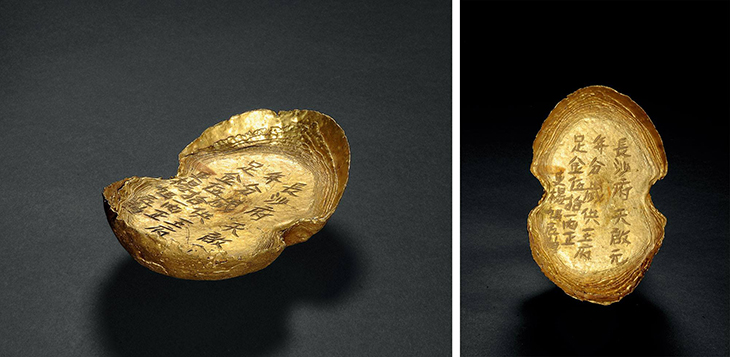
In the academic landscape of Hong Kong universities, there exists a textbook tailored for English readers that delves into the extensive history of China spanning 6,000 years. Within its pages, particularly in the section chronicling the political evolution of the nation, a discernible pattern emerges—a cyclical narrative wherein ruling dynasties ascend from peasant uprisings only to succumb to subsequent rebellions from the same demographic.
In the southern reaches of China’s Sichuan Province, a captivating chapter of history unfolds through a series of archaeological revelations. Over 70,000 artifacts, including gold, silver, bronze, military paraphernalia, and symbols of authority, bear witness to a doomed rebellion. This revolt sought to establish a new dynasty amidst the tumultuous downfall of the existing regime.
The epicenter of this historical drama lies at the confluence of the Min and Jin rivers. Here, an expedition led by the 17th-century peasant warlord Zhang Xianzhong faced an ambush while purportedly transporting his entire treasury—booty acquired from the subjugation of numerous small Ming Dynasty fiefdoms. This wealth was crucial for safeguarding his legitimacy and compensating his soldiers.
Rumors estimated the value of this treasure at a staggering one hundred million standard liang silver coins, equivalent to 8.8 million pounds of silver. Unfortunately for Zhang, the supreme commander of the Ming armies, Yang Zhan, orchestrated an assault that sent Zhang’s fleet, along with the invaluable treasure, thousands of soldiers, and any hope of ruling his proclaimed kingdom of Daxi, to the murky depths near the modern town of Jiangkou.
Recently highlighted in Archaeology Magazine, a publication under the Archaeological Institute of America, the saga unfolds through conversations with Chinese excavators. These modern explorers, akin to the generations of fishermen and royal officials before them, meticulously delve into the depths of the Jin and Min rivers in pursuit of Zhang’s lost treasure.
The team, hailing from the Sichuan Provincial Institute of Archaeology and Cultural Relics, has undertaken a substantial effort since 2016. They have dammed portions of the Min River near Jiangkou and surveyed a vast 250-acre riverbed, revealing hidden artifacts submerged beneath bedrock chutes. These relics, once concealed from divers and treasure hunters, are now being meticulously recovered by the excavation team, numbering in the tens of thousands.

“These finds not only verified historical records about the Jiangkou battle and the sunken treasure, but also shed light on the extensive social turmoil at a time of dynasty change, as well as on Zhang Xianzhong himself as a controversial historical figure,” said Liu Zhiyan of the Sichuan Provincial Institute and team leader of these excavations.
Conquest and Plunder
Zhang, arising from humble origins, embodied the archetype of an oriental despot who wielded absolute power over his predominantly agricultural subjects with an iron fist. Employing tactics of terror and raiding, he navigated the political landscape of the Ming Dynasty, leaving a trail of conquest and bloodshed evident in the artifacts discovered at the site of his fleet’s downfall.
The Ming Dynasty, like its predecessors, originated from a peasant rebellion that overthrew the Mongol-led Yuan Dynasty. Initially implementing effective administrative and economic reforms in Beijing, the Ming rulers, however, succumbed to flaws that manifested as cancerous tumors within their administration.
A significant flaw was the enfeoffment system, a bureaucratic process that granted county-sized landholding monopolies, or “fiefs,” to nobles. Empowered with “conferring tablets” to collect taxes, these fief lords transformed into quasi-emperors, exploiting the peasantry and plunging them into squalor and famine. It was within this context that Zhang emerged, leveraging his military prowess to lead a rebellion against the Ming Dynasty, carving a destructive path through the fiefdoms.
Artifacts recovered from the river near Jiangkou vividly narrate the tale of Zhang’s victories, predominantly comprising plunder from cities and palaces conquered during his campaign. Among the treasures are gold conferring tablets and symbols of office, such as a silver tablet commissioned by the King of Chu to the Ming Emperor for annual taxation, and a 200-year-old gold seal used by 13 generations of rulers from the Shu vassal state.
In 1643, Zhang’s forces seized the city of Changde, capturing another set of gold conferring tablets belonging to the King of Rong, a vassal to the emperor. The alignment of historical accounts with archaeological evidence on this rare occasion provides a vivid and corroborative glimpse into the tumultuous era marked by Zhang’s ascendancy and the subsequent fall of the Ming Dynasty.
“The items unearthed from the Jiangkou battleground site match well with Zhang’s route of conquest as recorded in the literature,” Liu said when she spoke to Archaeology Magazine’s Ling Xin.
Among the discoveries made were coins that were minted in Daxi, a short-lived kingdom established by Zhang in Sichuan Province. It’s noteworthy that only a solitary example of these coins had been previously identified in China.
Notably significant within the trove of findings was a regal seal attributed to Zhang himself. This seal, adorned with gold embellishments and featuring a tiger design, resonates with his warlord moniker, “huang lao hu” or “Yellow Tiger.”
Following the loss of his treasury, Zhang’s ascent to kingship took a tumultuous turn, described by some historians as descending into madness, albeit characterized by a heavy-handed tyranny. Internal disputes and tax enforcement led him to sack several of his own cities, fostering an atmosphere of chaos. Additionally, the defection of a considerable number of his troops to the Ming Dynasty further weakened Zhang’s hold on power.
What are your thoughts? Please comment below and share this news!
True Activist / Report a typo


